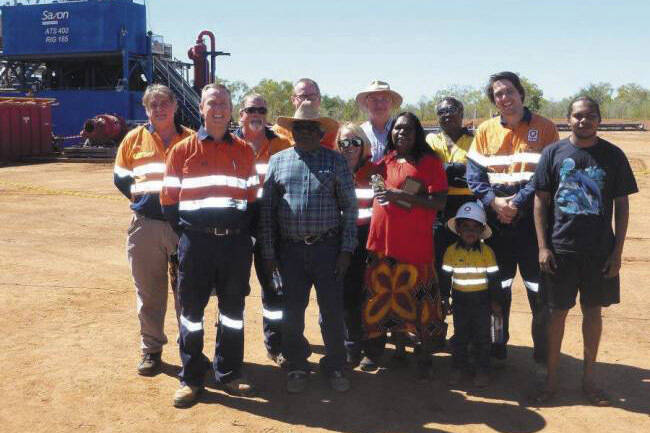Mining Exploration and Production
More than 80 percent of the value of minerals extracted in the Northern Territory comes from mining on Aboriginal-owned land, amounting to more than $1 billion a year. Approximately 30 percent of Aboriginal land is under exploration or currently under negotiation for exploration.
Welcome to country ceremony at Beetaloo/Jingaloo Outstation, July 2016.
Different processes apply for those wishing to mine and explore on land covered by the Land Rights Act (Aboriginal-owned land) and on land covered by the Native Title Act (land where Aboriginal people have native title interests). In all instances, where enterprises have entered into good faith negotiations and respected Aboriginal rights, agreements are being reached with benefit to all parties.
Facilitating exploration
While the Land Rights Act is primarily social justice legislation for the granting of traditional Aboriginal land in the Northern Territory for the benefit of Aboriginal people, it is clear that the Land Rights Act facilitates exploration and mining.
Established process
The Land Rights Act provides an established process which offers certainty for developers and landowners. The Land Council can ensure that the rightful owners are party to the consultations and negotiations; that any agreement is based on presentation of all relevant information in an objective manner; and that any agreement made will be honoured.
Under the Land Rights Act, Aboriginal landowners have the right to say 'yes' or 'no' to mining and minerals exploration on their land. Justice Woodward said in the findings of his Royal Commission into Aboriginal Land Rights: “I believe that to deny Aborigines the right to prevent mining on their land is to deny the reality of their land rights.”
Relevant legislation
The laws governing the granting of exploration licences and petroleum permits on Aboriginal land in the NT are the Northern Territory Mining Act 1980 and the Land Rights Act. An exploration licence or permit which allows the holder to explore for minerals or hydrocarbons cannot be issued by the NT Minister for Mines and Energy unless the applicant and the Land Council have entered into an agreement. Part IV of the Land Rights Act gives a clear procedure for a prospective company to obtain exploration and mining rights on Aboriginal land.
Royalties
An equivalent amount of royalties paid to the Northern Territory and Federal Governments for mining on Aboriginal land is paid to the Aboriginals Benefits Account. The ABA then distributes 30 percent of the royalties to Aboriginal people affected by the mining on their land, 40 percent of the royalties to Northern Territory Land Councils to administer their statutory responsibilities and a further 30 percent for the administration of the ABA and for distribution to Aboriginal people throughout the Northern Territory.
Exploration Licence Agreement - Process Summary
- Exploration Licence Application The mining company applies to the Northern Territory Department of Mines and Energy (DME) for a licence or permit.
- Consent to Negotiate The Minister for Mines and Energy grants the mining company 'consent to negotiate' with the NLC.
- Application for Consent The mining company must submit its application including exploration proposal and mining details to the NLC within three months, otherwise the application is deemed to have been withdrawn. The exploration proposal must describe all aspects of the exploration activity including possible impact on the environment and the social impacts.
- Acceptance or refusal Having ensured that the proposal provides adequate information for traditional landowners to make a decision, the NLC informs traditional owners and affected groups and communities within 30 days, and organises a meeting at which the applicant presents its proposal. A representative of the Federal Minister for Aboriginal Affairs may also attend the meeting. The traditional landowners have the right to instruct the NLC to refuse consent to an exploration proposal that affects their land. Refusal freezes the application for five years after which the same company may re-apply. Alternatively, traditional landowners may instruct the NLC to negotiate an agreement with the company.
- Negotiations Negotiations must be concluded within 12 months. The NLC provides the company with a draft exploration agreement containing fundamental clauses, and the company is invited to use this document as a basis for negotiations. A liaison committee of traditional landowners can be involved in negotiations. The negotiated agreement is then presented at a meeting of traditional landowners for their consideration.
- NLC Full Council Once the traditional landowners have instructed the Northern NLC to enter into the Agreement, their decision must be considered by the NLC Full Council to ensure that due process has been adhered to. The NLC must then seek the approval of the Federal Minister for Aboriginal and Torres Strait Islander Affairs to enter into the Agreement.
Once the Agreement has been executed by all parties, the NLC then notifies the Northern Territory Minister for Mines and Energy who subsequently issues the exploration licence for a period of six years, with an ability to extend for a further four years.
Mining and exploration under the Native Title Act
The Native Title Act is relevant for mining on Crown land and pastoral leases. Under the amended 1993 Native Title Act, provisions have been put in place which give registered applicants for determination of native title the "right to be consulted" over some types of mining and mineral exploration. The right to be consulted includes the right:
- to be notified;
- to lodge an objection;
- for objectors to be consulted;
- to be heard by an independent person; and
- to seek compensation for loss or impairment of native title rights and interests.
Those applicants intending to make an objection to an application for a mining or exploration lease have three months in which to formally lodge their objection with the Native Title Tribunal.


